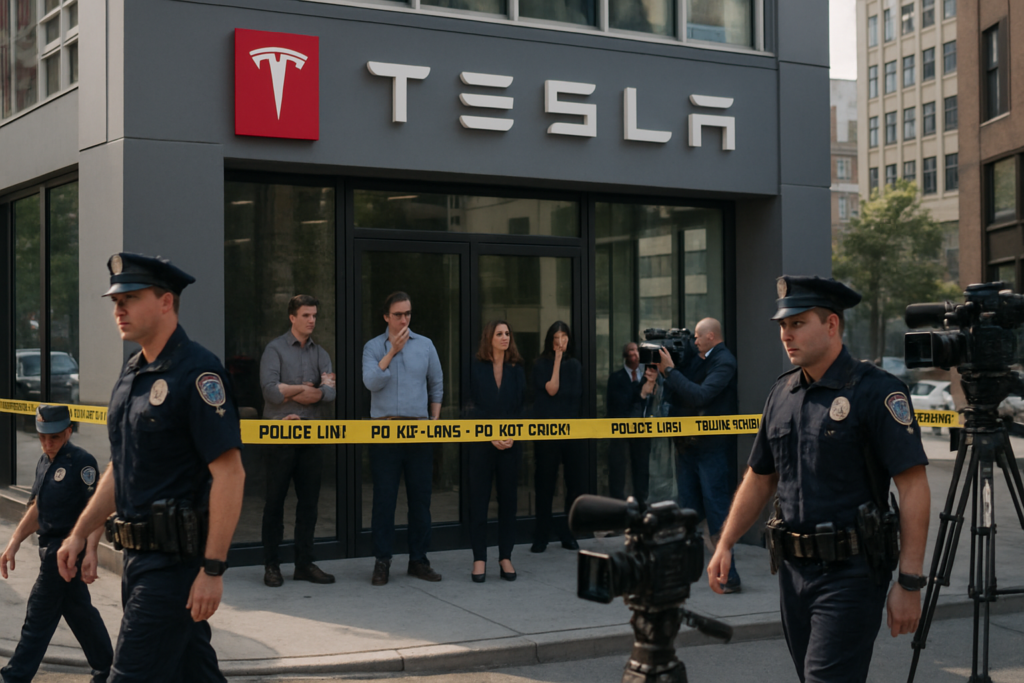FBI Reports Escalating Attacks on Tesla: Political Extremism and Security Risks
The FBI has issued a public warning about a significant rise in attacks on Tesla-owned locations as well as privately owned Tesla vehicles in recent months—a surge that exposes alarming vulnerabilities at the intersections of political extremism, technology, and public safety. These coordinated incidents, characterized by arson, gunfire, and property vandalism, have been tracked across at least nine states since January 2025, according to the FBI’s Internet Crime Complaint Center. While the company had previously relied on robust technological safeguards, perpetrators have found ways to circumvent these security measures, turning their ideological grievances into criminal destruction.
Tesla CEO Elon Musk (R), whose close affiliation with President Donald Trump (R) has drawn controversy from multiple corners of the political spectrum, has personally spoken out against the escalation. In a statement, Musk condemned the violence as “insane and deeply wrong,” urging a return to democratic dialogue instead of destructive action. The attacks have often involved graffiti expressing pointed grievances against perceived political opponents, as the FBI noted in its alert—making the ideological motivation unmistakable and raising concern about the polarization infecting public spaces.
The surge in attacks against Tesla is a stark signal that political disagreements are moving into physical and destructive territory, undermining the tenets of civil discourse.
Although incidents have primarily occurred under the cover of night, a pattern noticed by federal investigators, some Tesla owners report being targeted even during daylight hours. Individuals have shared disturbing accounts of property damage happening while they went about their daily routines, underscoring the emboldened approach taken by extremist actors.
Accountability, Technology, and Justice: Federal Response Intensifies
Responding to the attacks, authorities have moved swiftly. President Trump (R) and federal law enforcement have both labeled these acts as domestic terrorism. The Department of Justice has already charged three individuals, with sentences potentially reaching up to 20 years if convictions are secured, as reported by Axios. These measures are intended not only as punishment but also as deterrence against further escalation.
The use of technology has been pivotal in tracking suspects. The FBI highlights surveillance systems, social media tracking, and automatic license plate readers as essential tools in the apprehension of those responsible. This approach reflects a growing trend: law enforcement agencies are adapting to new forms of digital evidence and crowd-sourced intelligence, which can be crucial in countering decentralized threats. As noted by the FBI’s IC3 unit, social media postings often contain clues about attackers’ intent or identity—helping authorities move expediently from investigation to arrest (source).
Law enforcement capabilities have evolved, but so too have the methods of those who seek to inflict harm for political purposes. The current situation raises serious questions about privacy, surveillance, and the right approach to civil liberties in an age of digital accountability.
Nevertheless, these advancements also prompt community reflection. While justice must be served and public safety maintained, it remains vital to avoid overreach and respect the protections afforded to all citizens, regardless of political affiliation. These principles are at the heart of a functioning democracy, and any solution must be mindful of the fine balance between vigilance and liberty.
Tesla’s own security infrastructure, including vehicle cameras and site monitoring, was meant to act as a deterrent. Yet, as the Associated Press reports, these systems were unable to prevent every act of vandalism, highlighting the need for both technological and community responses. The resilience of Tesla employees, owners, and bystanders in the face of these attacks has been commendable, and many have taken action by reporting suspicious activity, contributing to the community’s overall safety network.
Broader Implications: Political Violence and the Path Forward for Civil Society
The recent incidents fit a troubling pattern of politically motivated violence targeting companies and leaders associated with controversial affiliations. The FBI’s findings indicate that these attacks are perpetrated by far-left extremists with strong ideological motivation, specifically in reaction to Musk’s vocal alignment with the Trump administration (Associated Press). This escalation comes at a time when public debate in the United States has grown increasingly polarized, and when technology companies often find themselves at the crosshairs of social movements for reasons far beyond business operations.
There is no question that protest and dissent are foundational rights in American democracy. However, when disagreements turn violent, the health of the broader society suffers. Attacks such as these create fear and division, feeding a cycle of retaliation and suspicion. The progressive response is not to endorse such violence but to reaffirm that lasting change—and lasting justice—comes through policy reform, civic engagement, and nonviolent resistance.
For communities concerned with the direction of the country, it’s more important than ever to channel frustration into organized, peaceful action and coalition-building, rather than destructive criminality.
Historical precedents reinforce these lessons. Movements that have achieved meaningful change—from labor rights to racial justice—did so through persistent, principled engagement with systems of power. While technology now provides new platforms for both dissent and accountability, the risks of digital radicalization and physical violence require renewed investment in de-escalation, dialogue, and collective solutions.
Improved community-police relations, civic education on protest rights and responsibilities, and platforms for inclusive dialogue are among the policy interventions that can bolster both public safety and democratic norms. These moments of crisis can be transformed into catalysts for unity; every constructive contribution—be it reporting suspicious behavior, participating in civic dialogue, or supporting restorative justice—matters in preventing further escalation.
Looking ahead, coordinated efforts between law enforcement, technology providers, community advocates, and engaged citizens remain the most promising way forward. If the past year has shown anything, it is that progress is possible when communities reject hatred and work together to create safer, more just public spaces for all.


